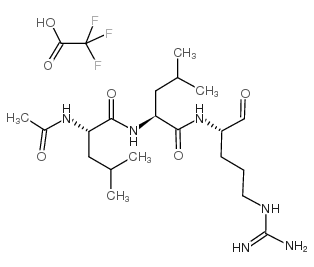Leupeptin trifluoroacetate salt

Leupeptin trifluoroacetate salt structure
|
Common Name | Leupeptin trifluoroacetate salt | ||
|---|---|---|---|---|
| CAS Number | 147385-61-3 | Molecular Weight | 540.57700 | |
| Density | N/A | Boiling Point | 775.4ºC at 760 mmHg | |
| Molecular Formula | C22H39F3N6O6 | Melting Point | N/A | |
| MSDS | Chinese USA | Flash Point | 422.7ºC | |
|
Modulation of tumor fatty acids, through overexpression or loss of thyroid hormone responsive protein spot 14 is associated with altered growth and metastasis.
Breast Cancer Res. 16(6) , 481, (2015) Spot14 (S14), encoded by the THRSP gene, regulates de novo fatty acid synthesis in the liver, adipose, and lactating mammary gland. We recently showed that S14 stimulated fatty acid synthase (FASN) activity in vitro, and increased the synthesis of fatty acids... |
|
|
Lipid phosphate phosphohydrolase type 1 (LPP1) degrades extracellular lysophosphatidic acid in vivo.
Biochem. J. 419 , 611-8, (2009) LPA (lysophosphatidic acid) is a lipid mediator that stimulates cell proliferation and growth, and is involved in physiological and pathological processes such as wound healing, platelet activation, angiogenesis and the growth of tumours. Therefore defining t... |
|
|
Role of nonspecific cytotoxic cells in bacterial resistance: expression of a novel pattern recognition receptor with antimicrobial activity.
Mol. Hum. Reprod. 46 , 953-61, (2009) Pattern recognition receptors (PRR) recognize invariant bacterial, viral, protozoan and certain synthetic ligands. PRR may be expressed as outer membrane (or endosomal) or cytosolic proteins and function to signal cell activation processes during inflammation... |
|
|
Role of STAT3 in glucocorticoid-induced expression of the human IL-10 gene.
Mol. Immunol. 45 , 3230-7, (2008) In the present report we have determined the molecular mechanisms, which govern the expression of the human IL-10 gene when induced by the glucocorticoid Methyl-Prednisolone (MP). Treatment of cells with MP at 10(-6) M will readily induce IL-10 in CD19+ prima... |
|
|
Cellular expression and antimicrobial function of a phylogenetically conserved novel histone 1x-like protein on mouse cells: a potential new class of pattern recognition receptor. Evans, D.L., et al.
J. Neurochem. 86 , 133-41, (2009)
|